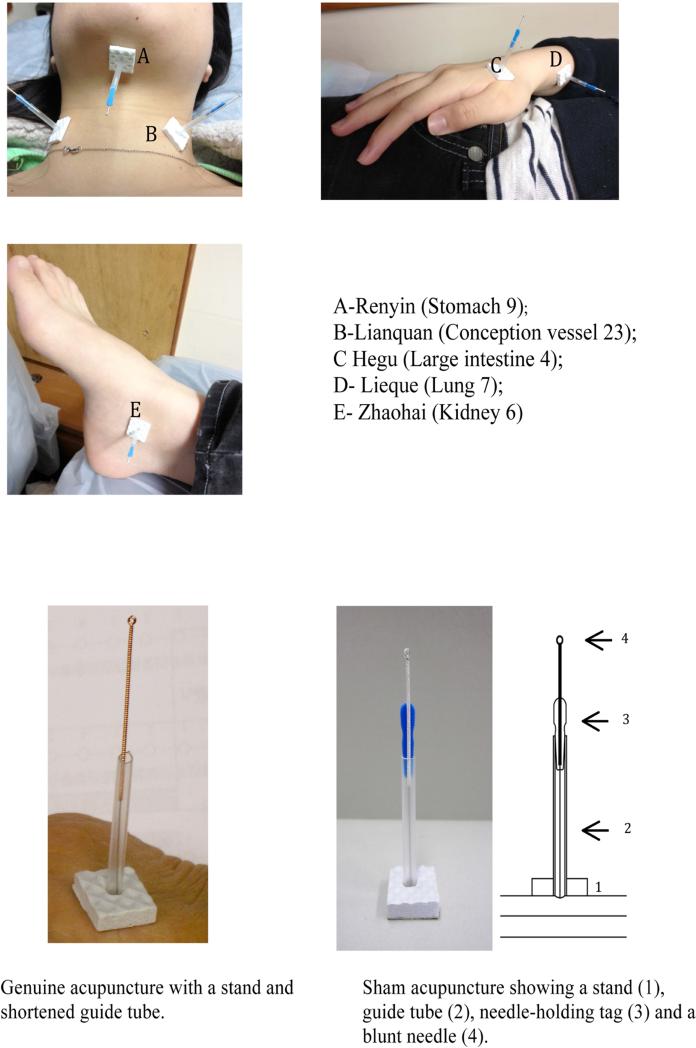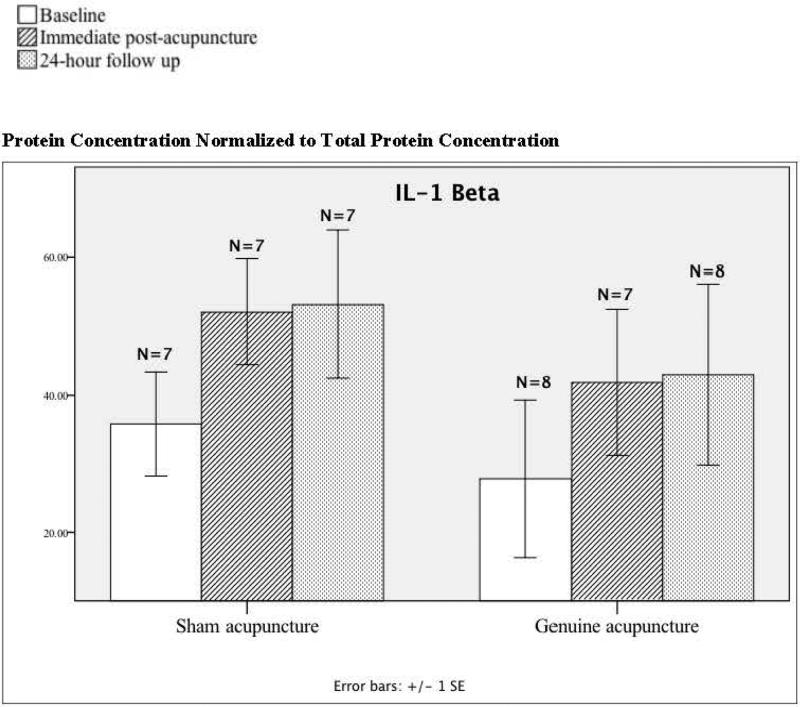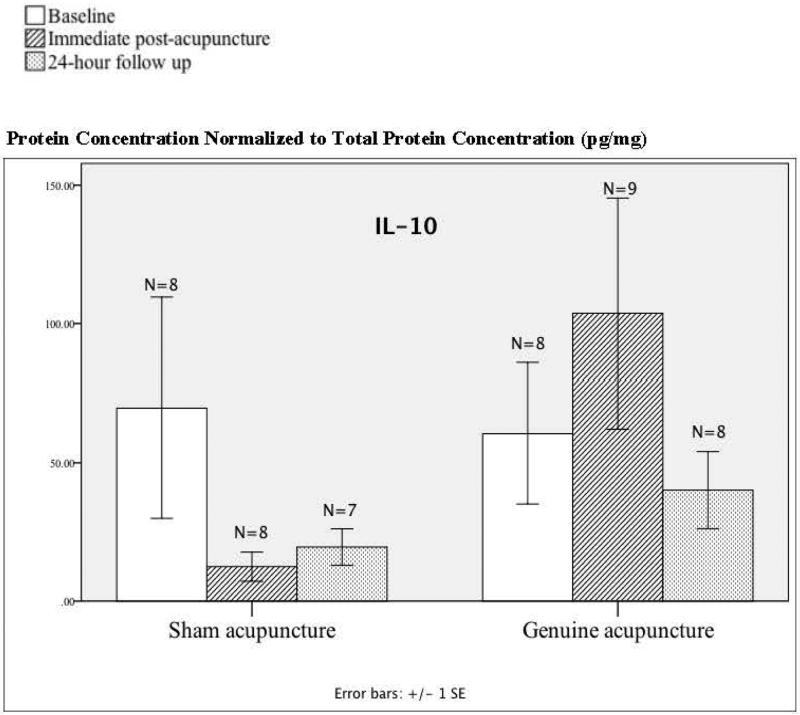Abstract
Objective
Acupuncture is a less invasive procedure when compared with surgical treatment for benign vocal pathologies caused by vocal overuse. This study aimed to determine the wound healing effect of acupuncture in treating phonotraumatic vocal fold lesions.
Study Design and Methods
The study used a two-way mixed-model between- and within-subjects, prospective randomized, placebo-controlled, blinded, group design. Seventeen dysphonic individuals with vocal nodules were recruited from a university clinic in Hong Kong. Each participant was randomly assigned to receive one session of either genuine or sham acupuncture. The genuine acupuncture group (N=9) received needles puncturing nine voice-related acupoints for 30 minutes; while the sham acupuncture group (N=8) received blunted needles stimulating the skin surface of the nine acupoints for the same frequency and duration. Laryngeal secretions were suctioned from the surface of the vocal folds immediately before, immediately after, and 24 hours after the acupuncture. The protein concentration levels of wound-healing related cytokines (interlukin IL-1 and IL-10) in these secretion samples were measured.
Results
Following acupuncture, a significant increased in the anti-inflammatory cytokine IL-10 was found in the genuine acupuncture group (N=9) but not in the sham acupuncture group (N=8).
Conclusions
The findings showed that acupuncture of voice-related acupoints facilitated an anti-inflammatory process in phonotraumatic vocal pathologies. This could be considered as supporting evidence to consider acupuncture as a less invasive alternative option, when compared to surgery, for treating phonotraumatic vocal pathologies.
Keywords: voice problems, laryngology, voice therapy, anti-inflammatory effect of acupuncture, alternative treatment, cytokine study
INTRODUCTION
Benign vocal fold pathologies, such as vocal nodules, polyps or chronic (or non-infectious) laryngitis, are common causes of voice problems that resulted from trauma to vocal fold tissue during phonation (phonotrauma) 1,2. Current treatment options generally include conservative behavioral voice therapy that allows the vocal pathologies to resolve through a wound healing process 3,4 or occasionally requiring surgery in some chronic conditions 5-7, supplemented by vocal hygiene education and behavioral voice therapy 8,9.
In recent years, more people seek for less invasive alternative treatment besides surgery10. Acupuncture has been shown to be effective in treating voice problems due to phonotrauma11. Subjects who received acupuncture at voice-related acupoints for 10 30-minute sessions of acupuncture over a period of one month11 demonstrated significantly greater improvements in the vocal function (maximum fundamental frequency produced) 11, voice quality severity (breathiness and roughness)11 and voice-related quality of life11 in terms of voice-related activity and participation according to the International Classification of Function12.
The mechanism of how acupuncture brings about physiological improvement in treating a variety of ailments is not fully understood. Different hypotheses have been put forward. For example, neurological blocking13 and neurological activation leading to corresponding healing activities in the wound14,15 have been proposed in pain control studies. It has been shown that acupuncture-like stimulation can promote the healing of wounds that are unresponsive to conventional treatment16. There are also a number of studies using animal models that showed wound healing are facilitated with the use of acupuncture17-20. Findings from these studies might well be used to hypothesize the wound healing effect of acupuncture on the benign vocal fold lesions.
The events of wound healing are highly organized and are governed by numerous biochemical markers including cytokines, growth factor, prostaglandins and metalloproteinases 21,22. In a study investigating the effects of acupuncture in patients with asthma23, acupuncture stimulation was found to affect the immune system by normalizing the concentrations of plasma cytokines. Based on this, we hypothesized that the acupuncture protocol reported in the study by Yiu et al11 was capable of promoting wound healing in benign laryngeal injuries commonly associated with phonotrauma. One would expect the concentrations of biochemical markers in damaged vocal folds to be altered by treatment. We therefore investigated whether biological changes (using cytokines as surrogate healing markers) would be observed in the vocal folds as a result of needling at the designated acupoints. The research hypothesis was that acupuncture, but not sham treatment, would improve the inflammatory profile of the vocal folds, which was estimated from the cytokine levels in the laryngeal secretions.
Objective
The objective of the study was to determine the level of anti-inflammatory cytokine (interleukin (IL)-10) and pro-inflammatory cytokine (IL-1β) level in the laryngeal secretion of subjects who were given acupuncture or sham acupuncture at the voice-related acupoints.
METHODS
The experimental protocol was approved by the Institutional Review Board of The University of Hong Kong/ Hospital Authority Hong Kong West Cluster/ (IRB# UW 07/004).
Participants
Seventeen dysphonic individuals with vocal nodules, recruited in February 2011 at the University of Hong Kong Voice Clinic, were assigned to either the genuine (N=9) or sham (N= 8) acupuncture groups. Participants had no knowledge of how acupuncture would be conducted. They were also free from any cardiovascular, neurological or respiratory disorders and did not receive any medication at the time of the study.
Procedures
Suctions of secretions from the larynx were carried out before the acupuncture procedure. Local anesthetics (5% lidocaine + 0.5% phenylephrine) were dropped down to the laryngeal inlet via the channel of the flexible laryngoscope under direct vision to provide local anesthesia for the suction to be carried out. A flexible laryngoscope (Olympus ENF-P4, Japan) with a disposable endoscope sheath with channel (Slide-On™ EndoSheath® , Medtronics, Jacksonville, FL) were used by an otolaryngologist (RT, co-author) to collect the secretion on the vocal fold surface24. A new endoscope sheath was used for each suction procedure. The secretions from both vocal folds were suctioned with the vocal folds adducted during phonation. The amount of secretion sample collected was approximately 1 cc. The channel was flushed with 0.5mL saline to flush out any remaining secretion in the channel. Each sample was transferred into an airtight eppendorf tube and immediately frozen to -80°C and stored in a freezer for subsequent biochemical analysis.
A 30-minute session of acupuncture (genuine or sham) was then given to each participant. The experimental group received needling that punctured nine acupoints, while the sham acupuncture group received stimulation on the skin surface of the acupoints using blunted needles. These acupoints are Hegu (Large Intestine 4) and Lieque (Lung 7) at the wrists, Lianquan (Conception vessel 23) and Renying (Stomach 9) around the neck and Zhaohai (Kidney 6) points on the ankles (Figure 1)11. With the group that received genuine acupuncture, each of the disposable stainless steel needles (0.25 mm diameter, 25 mm long with a 25 mm extended handle) was inserted through a 25 mm long guide tube (Hua Tuo Brand, Suzhou Medical Appliance, Suzhou, China) with one end attached to an opening in the center of a foam board (1 cm x 1 cm) taped to the skin surface of each acupoints (see Figure 1 showing the needle in a guide tube).
Figure 1.
Needling position and needle design.
The needling depth is typically about 13 mm for Zhaohai, Hegu and Lianquan and 5-8 mm for Lieque and Renyin acupoints 25. For the group that received the sham acupuncture, blunted acupuncture needles were used 26. The blunt needle end was used to exert pressure on the skin surface without penetrating the skin. Each blunt needle was held in place by using a stopper inserted into the opening of the guide tube (see also Figure 1).
Each needle was twirled in the acupoint (acupoint twirling for genuine acupuncture) or on the skin surface of the acupoint (skin surface twirling for sham acupuncture) every five minutes for 30 minutes. Since all the subjects had no prior experience of acupuncture, it is reasonable to expect that the participant could not tell whether they had genuine acupuncture (acupoint twirling) or the sham acupuncture (skin surface twirling). Vocal fold secretions were collected again immediately after the acupuncture procedure and then again 24 hours after the acupuncture.
Sample analysis
All laryngeal secretion sample analyses were carried out at the Oral BioSciences Laboratory, The University of Hong Kong using enzyme-linked immunosorbent assay (ELISA) kit (by RayBiotech, Inc., Norcrss, GA). The concentrations of biochemical markers (in pg / mg of protein) pro-inflammatory cytokine IL-1β and anti-inflammatory cytokine IL10 were determined.
Data analysis
This study employed a prospective, randomized, 2-way mixed-model, repeated-measures placebo-control group design. The between-subjects independent variable was group assignment (i.e. genuine acupuncture versus sham acupuncture), and the within-subjects independent variable was the time point (a pre-needling and 2 post-needling time points). Dependent variables were concentrations of two major biochemical markers, namely pro-inflammatory (IL-1β) and anti-inflammatory cytokine IL10, as these markers have been shown to predominate in acute and chronic phonotraumatic injury 24. Statistical tests were carried out using SPSS version 20.
RESULTS
Results showed that the pro-inflammatory IL-1β level increased significantly over time (Friedman's 2-way ANOVA=7.6, df=2, p=0.02; see Figure 2) in the sham acupuncture group while the changes in the genuine acupuncture group was not significant (Friedman test: chi square =1, df=2, p=0.61). While for the anti-inflammatory cytokine IL10, the genuine acupuncture group demonstrated a marginally significant increase after the acupuncture (Friedman's 2-way ANOVA=6, df=2, p=0.05; see Figure 3), while the sham acupuncture group showed no significant changes over time (Friedman test: chi square =2.57, df=2, p=0.28). The anti-inflammatory effect was, however, only short living and the increased IL10 level could not be maintained at the 24-hour follow-up time point.
Figure 2.
Mean level of pro-inflammatory IL-1 beta over time.
Figure 3.
Mean level of anti-inflammatory IL10 over time.
DISCUSSION
The pro-inflammatory IL-1β level continued to increase significantly over time in the group with sham-acupuncture. There was, however, no significant change with the IL-1β level in the group with genuine acupuncture. These results suggested that the inflammatory condition in the sham acupuncture was continuing, while that of the genuine acupuncture group was stabilized. On the other hand, the anti-inflammatory IL-10 level increased (p=0.05) following genuine acupuncture but decreased with the sham acupuncture. Admittedly, the sample size was small (N=17). Nevertheless, this effect suggested that acupuncture indeed facilitated an anti-inflammatory process at the laryngeal level of the body. It should be noted that the anti-inflammatory effect was only short living and the increased IL-10 level could no longer be maintained after 24 hours (see Figure 3).
CONCLUSION
Contemporary treatment options for benign vocal fold pathologies related to phonotrauma involved conservative voice exercise therapy and possibly surgery 6,9. Given the invasiveness and risk associated with phono-surgery for phonotraumatic vocal lesions, it is not difficult to understand that many patients would look for alternative treatment options. Many anecdotal reports and more recently randomized trials 11 have shown the acupuncture can effectively treat this problem. Being a less invasive procedure compared to surgical treatment, we have proposed that acupuncture can be considered as an alternative management option for chronic phonotraumatic vocal fold lesions. The underlying mechanism of the effectiveness of acupuncture in treating phonotraumatic lesions could probably be attributed to its facilitation of wound healing.
The increase of anti-inflammatory IL-10 level in the laryngeal secretion following acupuncture but not in the sham-acupuncture group suggested that the acupuncture itself facilitated such change. The anti-inflammatory effect of acupuncture has also be found in other disease models27-29. It remains, however, uncertain how and why acupuncture could facilitate such wound healing effect. We hypothesize that the use of needling at the Renyin acupoints near the larynx could have facilitated the blood circulation and nerve endings stimulation around the larynx, which subsequently enhanced wound healing. If this were the case, then would the needling at the other acupoints distal from the larynx be necessary? According to the traditional Chinese medicine principle, needling at the other acupoints are essential, if not supplementary, in order to achieve a balanced outcome. In evidence-based practice medicine, this remains to be answered by setting up trials to compare the effects of acupuncture with just the acupoints next to the larynx with those when a complete set of traditional acupoints are to be used.
Acknowledgments
Financial Disclosure: The study was supported in part by grants awarded by National Center for Complementary and Alternative Medicine, National Institute of Health (#R21 AT003879-01) and the Hong Kong Research Grant Council (HKU782509-2009).
Footnotes
Conflict of Interest: None
REFERENCES
- 1.Franco RA, Andrus JG. Common diagnoses and treatments in professional voice users. Otolaryngol Clin North Am. 2007;40:1025–1061. vii. doi: 10.1016/j.otc.2007.05.008. [DOI] [PubMed] [Google Scholar]
- 2.Verdolini K, Rosen C, Branski RC. Classification manual for voice disorders– I. Erlbaum; Mahwah, NJ: 2006. [Google Scholar]
- 3.Nakagawa H, Miyamoto M, Kusuyama T, Mori Y, Fukuda H. Resolution of vocal fold polyps with conservative treatment. J Voice. 2012;26:e107–110. doi: 10.1016/j.jvoice.2011.07.005. [DOI] [PubMed] [Google Scholar]
- 4.Wang CT, Liao LJ, Lai MS, Cheng PW. Comparison of benign lesion regression following vocal fold steroid injection and vocal hygiene education. Laryngoscope. 2014;124:510–515. doi: 10.1002/lary.24328. [DOI] [PubMed] [Google Scholar]
- 5.Pannabacker M. Treatment of Vocal Nodules: Options and Outcomes. Am J Speech Lang Pathol. 1999;8:207–217. [Google Scholar]
- 6.Zeitels SM, Casiano RR, Gardner GM, Hogikyan ND, Koufman JA, Rosen CA. Management of common voice problems: Committee report. Otolaryngol Head Neck Surg. 2002;126:333–348. doi: 10.1067/mhn.2002.123546. [DOI] [PubMed] [Google Scholar]
- 7.Dworkin JP, Meleca RJ. Vocal Pathologies: Diagnosis, Treatment and Case Studies. Singular Publishing; San Diego: 1997. [Google Scholar]
- 8.Rubin JS, Yanagisawa E. Benign vocal fold pathology through the eyes of the laryngologist. In: Rubin JS, Sataloff RT, Korovin GS, editors. Diagnosis and Treatment of Voice Disorders. 2nd ed. Thomson Learning, Inc.; New York: 2003. [Google Scholar]
- 9.Bequignon E, Bach C. Fugain Cet al. Long-term results of surgical treatment of vocal fold nodules. Laryngoscope. 2013;123:1926–1930. doi: 10.1002/lary.23768. [DOI] [PubMed] [Google Scholar]
- 10.Harris P, Rees R. The prevalence of complementary and alternative medicine use among the general population: a systematic review of the literature. Complement Ther Med. 2000;8:88–96. doi: 10.1054/ctim.2000.0353. [DOI] [PubMed] [Google Scholar]
- 11.Yiu E, Xu JJ. Murry Tet al. A randomized treatment-placebo study of the effectiveness of acupuncture for benign vocal pathologies. J Voice. 2006;20:144–156. doi: 10.1016/j.jvoice.2004.11.007. [DOI] [PubMed] [Google Scholar]
- 12.World Health Organization . International Classification of Functioning, Disability and Health, ICF. World Health Organization; Geneva: 2001. [Google Scholar]
- 13.Sierpina VS, Frenkel MA. Acupuncture: a clinical review. South Med J. 2005;98:330–337. doi: 10.1097/01.SMJ.0000140834.30654.0F. [DOI] [PubMed] [Google Scholar]
- 14.Cho ZH, Na CS, Wang EK, Lee SH, Hong IK. Functional Magnetic Resonance Imaging of the Brain in the Investigation of Acupuncture. In: Stux G, Hammerschlag R, editors. Clinical Acupuncture. Scientific Basis. Springer; Heidelberg: 2001. pp. 83–95. [Google Scholar]
- 15.Li G, Cheung RT, Ma QY, Yang ES. Visual cortical activations on fMRI upon stimulation of the vision-implicated acupoints. Neuroreport. 2003;14:669–673. doi: 10.1097/00001756-200304150-00002. [DOI] [PubMed] [Google Scholar]
- 16.Sumano H, Mateos G. The use of acupuncture-like electrical stimulation for wound healing of lesions unresponsive to conventional treatment. Am J Acupuncture. 1999;27:5–14. [PubMed] [Google Scholar]
- 17.de Almeida Mdos S, de Aro AA, Guerra Fda R, Vieira CP, de Campos Vidal B, Rosa Pimentel E. Electroacupuncture increases the concentration and organization of collagen in a tendon healing model in rats. Connect Tissue Res. 2012;53:542–547. doi: 10.3109/03008207.2012.710671. [DOI] [PubMed] [Google Scholar]
- 18.Inoue M, Nakajima M, Hojo T, Itoi M, Kitakoji H. The effect of electroacupuncture on osteotomy gap healing in a rat fibula model. Acupunct Med. 2013;31:222–227. doi: 10.1136/acupmed-2012-010294. [DOI] [PubMed] [Google Scholar]
- 19.Lee JA, Jeong HJ, Park HJ, Jeon S, Hong SU. Acupuncture accelerates wound healing in burn-injured mice. Burns. 2011;37:117–125. doi: 10.1016/j.burns.2010.07.005. [DOI] [PubMed] [Google Scholar]
- 20.Park SI, Sunwoo YY, Jung YJ. Therapeutic Effects of Acupuncture through Enhancement of Functional Angiogenesis and Granulogenesis in Rat Wound Healing. Evid Based Complement Alternat Med. 2012;2012:464586. doi: 10.1155/2012/464586. [DOI] [PMC free article] [PubMed] [Google Scholar]
- 21.Hunt TK, Hopf H, Hussain Z. Physiology of wound healing. Adv Skin Wound Care. 2000;13:6–11. [PubMed] [Google Scholar]
- 22.Verdolini K, Rosen CA, Branski RC, Hebda PA. Shifts in biochemical markers associated with wound healing in laryngeal secretions following phonotrauma: a preliminary study. Ann Otol Rhinol Laryngol. 2003;112:1021–1025. doi: 10.1177/000348940311201205. [DOI] [PubMed] [Google Scholar]
- 23.Jeong HJ, Kim BS, Oh JG, Kim KS, Kim HM. Regulatory effect of cytokine production in asthma patients by SOOJI CHIM (Koryo Hand Acupuncture Therapy). Immunopharmacol Immunotoxicol. 2002;24:265–274. doi: 10.1081/iph-120003759. [DOI] [PubMed] [Google Scholar]
- 24.Branski RC, Rosen CA, Verdolini K, Hebda PA. Markers of wound healing in vocal fold secretions from patients with laryngeal pathology. Ann Otol Rhinol Laryngol. 2004;113:23–29. doi: 10.1177/000348940411300105. [DOI] [PubMed] [Google Scholar]
- 25.Lin JG, Chou PC, Chu HY. An exploration of the needling depth in acupuncture: the safe needling depth and the needling depth of clinical efficacy. Evid Based Complement Alternat Med. 2013;2013:740508. doi: 10.1155/2013/740508. [DOI] [PMC free article] [PubMed] [Google Scholar]
- 26.Tough EA, White AR, Richards SH, Lord B, Campbell JL. Developing and validating a sham acupuncture needle. Acupunct Med. 2009;27:118–122. doi: 10.1136/aim.2009.000737. [DOI] [PubMed] [Google Scholar]
- 27.Petti FB, Liguori A, Ippoliti F. Study on cytokines IL-2, IL-6, IL-10 in patients of chronic allergic rhinitis treated with acupuncture. J Tradit Chin Med. 2002;22:104–111. [PubMed] [Google Scholar]
- 28.da Silva MD, Guginski G, Werner MF, Baggio CH, Marcon R, Santos AR. Involvement of Interleukin-10 in the Anti-Inflammatory Effect of Sanyinjiao (SP6) Acupuncture in a Mouse Model of Peritonitis. Evid Based Complement Alternat Med. 2011;2011:217946. doi: 10.1093/ecam/neq036. [DOI] [PMC free article] [PubMed] [Google Scholar]
- 29.Zijlstra FJ, van den Berg-de Lange I, Huygen FJ, Klein J. Anti-inflammatory actions of acupuncture. Mediators Inflamm. 2003;12:59–69. doi: 10.1080/0962935031000114943. [DOI] [PMC free article] [PubMed] [Google Scholar]





